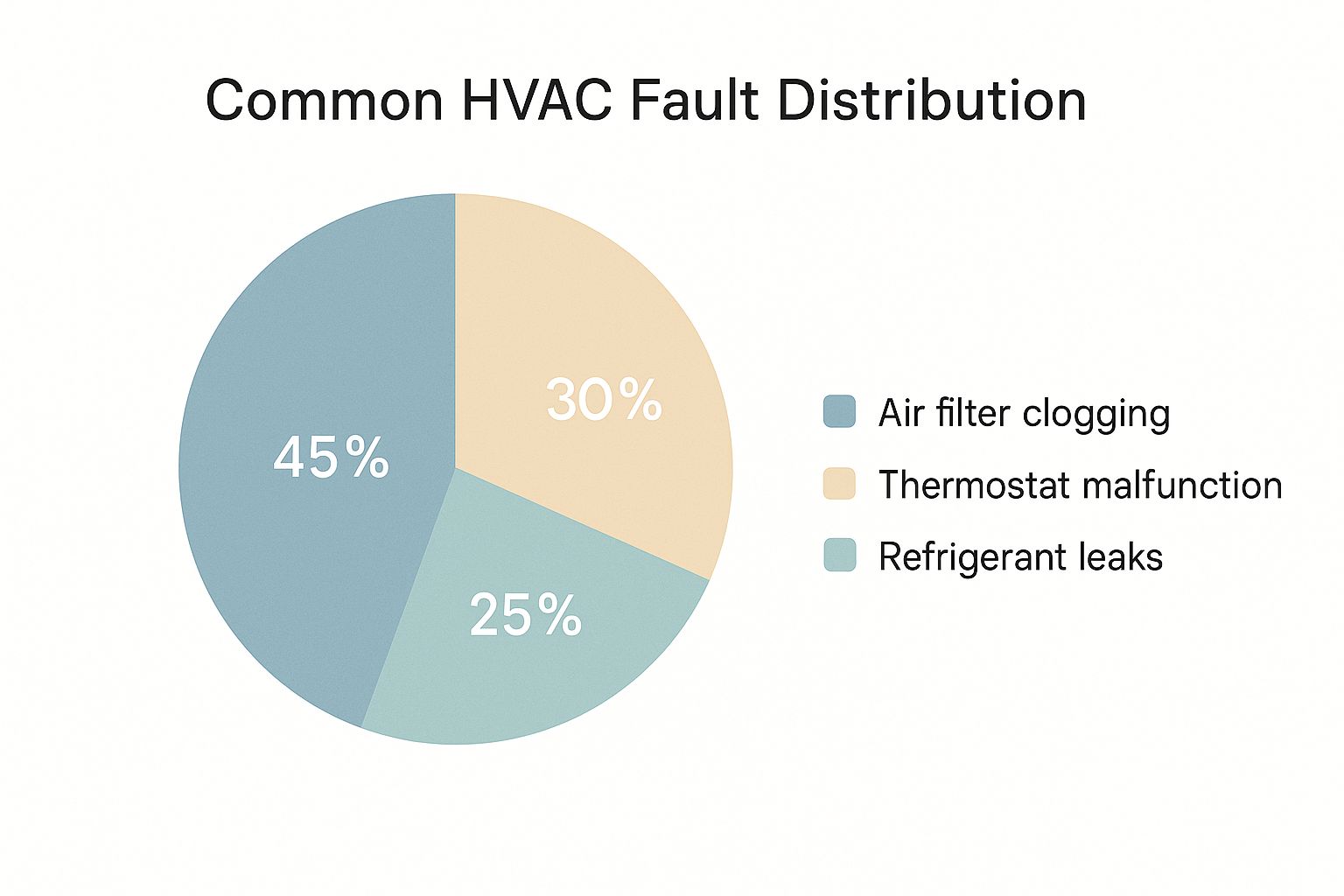Understanding What Your HVAC System Is Really Telling You
After two decades spent in crawl spaces and equipment rooms, I can tell you that successful HVAC troubleshooting isn't about owning the latest gadgets. It's about developing a sixth sense for what your system is trying to tell you. Every seasoned HVAC tech has those moments where they walk into a mechanical room and just know something's off, before even touching a tool.
This diagnostic intuition isn't magic. It's experience. A tiny vibration that most people wouldn't notice can scream "bearing wear" to a trained ear. A small temperature difference between supply and return air? That might whisper "airflow problems" lurking in your ductwork. Even the subtle hum of a running compressor can reveal developing electrical issues.

The Wikipedia diagram above shows how everything's connected in an HVAC system. A problem in one spot can trigger issues somewhere else entirely. This understanding is key to effective troubleshooting. Connecting those seemingly random symptoms into a clear diagnostic picture – that’s the secret to efficient HVAC repair. And speaking of efficient, the HVAC maintenance and repair industry is booming. It's projected to jump from $22.5 billion in 2023 to a whopping $37.8 billion by 2032, fueled by growing demand in densely populated areas. You can check out more insights into the expanding HVAC market here.
Developing this skillset takes more than just memorizing codes from an HVAC troubleshooting guide. It’s about becoming the go-to tech, the one who sees solutions where others see mysteries.
Choosing the Right Diagnostic Tools
This means knowing which tools actually matter in the field. Let's face it, some are more useful than others. To help you navigate the options, I've put together a comparison table based on my own field experience. It breaks down the cost, effectiveness, and typical uses of some essential diagnostic tools.
The following table provides a practical comparison of essential HVAC diagnostic tools, considering factors like cost, effectiveness, and typical use cases. These insights are drawn from real-world field experience, offering a valuable guide for technicians.
As you can see, some tools offer a higher return on investment than others. While a manometer is useful, tools like multimeters, clamp meters, thermometers, and leak detectors are absolute must-haves for any HVAC technician. They pay for themselves quickly through faster diagnostics and more accurate repairs.
Reading Between the Lines: System Performance Patterns
Beyond tools, it's about learning to read the performance patterns of your HVAC system. These are the subtle hints that predict problems before they become emergencies. It's about knowing the difference between treating the symptoms and actually finding the root cause. This proactive approach not only saves your clients money by preventing costly breakdowns, but it also extends the lifespan of their equipment. And that builds your reputation as a reliable expert.
Mastering The Core Problems Every Technician Faces
Let's talk HVAC troubleshooting. Specifically, those bread-and-butter service calls: heating failures, cooling breakdowns, and airflow disasters. These probably make up the lion's share of your tickets. Ever notice how some techs breeze through these while others get bogged down for hours? I remember this one commercial kitchen – the owner was losing his mind (and money) because half the dining room felt like the Sahara and the other half was an icebox. The last tech had thrown a new thermostat at it, cleaned the ducts, even swapped out a blower motor. No dice. Turned out, a single damper actuator was stuck halfway.
That, my friends, highlights a key point. It's not enough to know how to fix things; you have to understand how these core problems relate to each other. A heating problem can easily masquerade as an airflow issue. And guess what? Cooling complaints can sometimes stem from something wonky in the heating system. This interconnectedness is the secret sauce that separates efficient troubleshooting from a costly parts-replacing spree.
Recognizing Diagnostic Patterns
Think of diagnostic patterns like clues at a crime scene. They're telltale signs pointing you to the root cause. For example, a system that's constantly short-cycling? Could be a refrigerant leak or a compressor on its last leg. Uneven temperatures between zones? Suspect a faulty zoning system or ductwork blockage. Learning to spot these patterns is like getting a superpower – your troubleshooting speed and accuracy will skyrocket.
Beyond Quick Fixes: A Systematic Approach
We’ve all been there – tempted to slap a Band-Aid on a problem and call it a day. Sure, it might work temporarily, but you're practically guaranteeing a callback. Trust me, a systematic approach is worth its weight in gold. That means thoroughly inspecting all the relevant components and using a logical process of elimination. You’re fixing the problem, not just masking the symptoms.
The Economic Impact of HVAC Troubleshooting
Here's a little food for thought. The US HVAC market was valued at about $30.41 billion in 2023 and is expected to grow at a CAGR of 7.4% through 2030. That's huge! This growth is fueled by increased HVAC infrastructure investment and the push for greener systems. Discover more insights on the HVAC market. On top of that, Americans shell out roughly $14 billion every year on HVAC services and repairs. That’s a lot of money being spent to keep things cool (and warm). This just underscores how vital good troubleshooting is. It minimizes operating costs, extends equipment lifespan, and keeps your customers happy. By honing your diagnostic skills, you’re not just fixing systems, you're contributing to a major part of the economy.

Mastering these core troubleshooting principles gets you out of the guessing game and into a confident, systematic approach that fixes things right the first time. That means happier customers, fewer callbacks, and a healthier bottom line for your business.
Conquering Electrical Issues Without The Guesswork

Electrical problems in HVAC systems have a reputation for being tricky. But honestly, they’re pretty predictable once you grasp the fundamentals. I’ve witnessed countless talented technicians get completely baffled by electrical gremlins, simply because they went at the problem haphazardly.
It's like trying to find your way around a new city without a map or GPS. You need a plan. A solid HVAC troubleshooting guide PDF can be a lifesaver here.
Real-World Electrical Mysteries Solved
Let me share a couple of real-world examples. I once spent hours troubleshooting a rooftop unit on a commercial building. The breakers kept tripping intermittently. Everything looked perfect on the surface, but something was causing an overload. After systematically tracing the circuit, I finally found the culprit: a chafed wire rubbing against the unit's metal casing.
Another time, I was called to a house where the thermostat was working fine, but the HVAC equipment was completely unresponsive. After some investigation, it turned out a small relay on the control board had died.
These stories highlight a key principle: a systematic approach is essential. Don’t just guess; understand the electrical flow and follow it step-by-step.
Decoding Voltage Readings and Common Failure Points
One thing that separates the experienced HVAC technicians from the newbies is the ability to interpret voltage readings. What you see on your multimeter doesn't always tell the whole story. A low voltage reading might mean you’ve found the bad component, or it could point to a problem further upstream. This is where your wiring diagrams and schematics become invaluable.
Also, some components are simply more likely to fail than others. Capacitors, contactors, and relays are frequent offenders in electrical malfunctions. Knowing these common weak points lets you narrow down your search and focus your diagnostic efforts. You’re not just randomly testing parts; you're using your knowledge to identify the most likely suspects.
Building Confidence With Electrical Troubleshooting
I know working with electrical systems can be daunting, especially when you're faced with something unfamiliar. But with a methodical approach and a reliable HVAC troubleshooting guide pdf, you can tackle even the most complicated electrical problems with confidence. This includes understanding control schemes and integrated systems that may seem overwhelming at first.
The more you practice tracing circuits, interpreting those multimeter readings, and identifying common failure points, the more confident you’ll become in your ability to diagnose and repair electrical issues quickly and safely. This isn't about memorizing everything; it's about developing a real, practical understanding of how electricity works in HVAC systems, and how to find those disruptions. It’s about becoming the technician who solves electrical mysteries, not the one who gets stumped by them.
Reading Refrigeration Systems Like A Detective Story
When you really get to know the refrigeration cycle, pressure readings become more than just numbers; they tell a story. They're clues about how the system is doing. I've seen techs scratching their heads over readings that seem impossible, like high suction pressure with low discharge pressure, until they figured out how to interpret what the system was trying to tell them. Troubleshooting becomes almost second nature once you grasp how each component affects the others, and how a problem in one spot can show up as symptoms somewhere else entirely. The infographic below visualizes the distribution of common HVAC faults, offering valuable insights for technicians tackling these everyday challenges.

As you can see, clogged air filters are the culprit in a whopping 45% of HVAC problems. Thermostat issues come in second at 30%, and refrigerant leaks round out the top three at 25%. This really highlights why regular maintenance and checking these components first are so important. This knowledge, along with a solid hvac troubleshooting guide pdf (do a search, there are tons!), can really boost your diagnostic speed. It's interesting to note that the global HVAC market is expected to hit $296.92 billion by 2028, with a 12.7% annual growth rate. That shows you the huge demand for skilled technicians who know how to diagnose and fix these systems. Want to dive deeper into the exploding HVAC market? Check out the details here.
Decoding Pressure Readings: Real-World Scenarios
Let me share a couple of real-world examples from my experience. I remember one system with both low suction and discharge pressures. My initial thought? Refrigerant leak. Classic, right? But after digging a little deeper, I found a restricted expansion valve. It was starving the evaporator of refrigerant, mimicking a leak. Another time, high superheat pointed towards low refrigerant, but it turned out to be a filthy condenser coil preventing proper heat transfer.

The screenshot above, from the Wikipedia page on refrigeration, shows the main components of a refrigeration cycle. Understanding how these parts work together, and how pressure changes reflect those interactions, is key to accurate diagnosis.
Superheat and Subcooling: Your Diagnostic Allies
Superheat and subcooling measurements are more than just maintenance checks – they're your secret weapons for troubleshooting. Superheat gives you the lowdown on evaporator performance, while subcooling tells you what's happening in the condenser. Use them together, and you get a much clearer understanding of the system's overall operation. This allows you to move beyond basic pressure checks and get to the root of the problem. Trust me, it saves you a lot of time and prevents swapping out parts that are perfectly fine.
Now, let's look at a handy chart I put together to help you decipher those pressure readings. It summarizes some common scenarios and gives you a starting point for your troubleshooting:
Refrigerant Pressure Troubleshooting ChartCommon pressure readings and their corresponding system conditions, with troubleshooting guidance for each scenario
This chart provides a general guideline, but always consider the specific system and its environment.
Beyond the Textbook: Real-World System Quirks
Keep in mind, textbook examples don’t always reflect what you’ll find in the field. Things like the temperature outside, how old the system is, and even quirky installation choices can affect pressure readings. Experience is what teaches you to recognize these anomalies and adapt your diagnostic approach. That kind of adaptable thinking, based on a solid understanding of the fundamentals, is what truly makes a skilled technician.
Navigating Smart Systems Without Losing Your Mind
Today's HVAC systems are brimming with smart controls, variable speed parts, and diagnostic capabilities. These features can be incredibly helpful, sure, but also a real headache sometimes. I've personally seen systems throw out a huge list of error codes, and most of them weren't even the root cause, just symptoms. Other times, systems fail without a peep, leaving you scratching your head. The key is knowing when to trust the system's diagnostics and when to trust your own gut.
Deciphering the Digital Maze
So, your smart system is throwing error codes at you like it's celebrating New Year's Eve. Don't panic! Remember, these systems are supposed to make your life easier, not harder. A good HVAC troubleshooting guide PDF can be your best friend in these situations. A quick Google search will turn up tons of resources.
Let's say you see a “low airflow” error. You might immediately suspect the blower motor. But what if it's perfectly fine? The real problem could be anything from a clogged filter to a closed damper, or even a restriction in the ductwork. Think of the error code as a clue, not the solution.
The Problem With Error Codes: Symptoms Vs. Causes
Here’s the deal with error codes: they often tell you what's wrong, not why it's wrong. It’s like a cough. Could be a cold, could be something worse. Same goes for HVAC. A “low refrigerant” code could indicate a leak, sure, but it could also be a faulty expansion valve or a system restriction. This is where your experience comes in. You’ve got to dig deeper to find the root cause. It's like detective work, honestly.
When Smart Controls Mask Mechanical Problems
Believe it or not, sometimes these advanced control systems can actually hide simple mechanical problems. I once worked on a system that kept shutting down because of a “high pressure” fault. The smart controls were constantly adjusting fan speeds and modulating valves, trying to compensate. Turns out, the condenser coil was caked in dirt. A quick cleaning fixed the problem. The technology was so focused on fixing the symptom, it completely missed the obvious cause.
Troubleshooting Communication Breakdowns
Smart systems rely on different components talking to each other. When that communication breaks down, things get… interesting. Let’s say the thermostat sends signals to the furnace, but the furnace isn't getting them. The system might shut down, cycle erratically, or simply refuse to work. Troubleshooting this requires understanding how the different components communicate. Wiring diagrams and system schematics become essential tools. They show you the communication pathways and help pinpoint where the signal is getting lost.
Taming the Unpredictable: Complex Control Logic
Lastly, let's talk about control logic. Modern systems can have really complex control algorithms that don't always behave as you’d expect. A minor change in one setting can have ripple effects throughout the system. This requires patience, a willingness to tinker, and a deep understanding of how the system should work. It's like learning a new language. The goal is to embrace the technology as a tool, but keep your diagnostic skills honed. It's about combining smart systems with smart technicians.
Creating Your Personal Diagnostic Framework
Every seasoned HVAC technician I know develops a unique troubleshooting approach. It's like a personal system, fine-tuned over years of experience—especially those late-night calls that teach you things no manual ever could. This section will help you build that framework intentionally, instead of just hoping it'll magically appear with time. You're in the driver's seat here.
Building Your Diagnostic Checklist
Think of a diagnostic checklist less as a rigid set of rules and more like a flexible guide. It keeps you organized and prevents you from skipping crucial steps, especially when you’re tired. I remember one commercial kitchen job with uneven temperatures… a simple checklist that included checking the damper actuator would have saved the previous tech hours of wasted time. A good checklist isn't about slowing you down; it’s about making sure you cover everything efficiently.
As HVAC systems get smarter, understanding Large Language Models and their role in these systems can be really helpful. It gives you a deeper insight into the tech you’re working with.
Documenting Your Journey: Learning From Every Call
Good documentation is like creating your own personal HVAC troubleshooting PDF, tailored to your experiences. Every service call is a chance to learn something new. Don’t just record the problem and the solution. Write down your entire diagnostic process: the clues you saw, the tests you ran, even the things that didn't work. This builds an incredibly valuable resource for the future. I used to keep a detailed logbook, and it saved me countless hours over the years. When I came across similar issues later, I could quickly review my notes and avoid repeating past mistakes.
Building Your Network: The Power of Collaboration
Troubleshooting isn't a solo mission. Building relationships with other technicians, suppliers, and even engineers gives you access to a huge network of knowledge and experience. I once had a problem in an office building with a breaker that kept tripping. A quick call to a trusted electrician saved me hours of tracing wires. Sometimes a fresh perspective or a different approach is all it takes to solve a tough problem.
Staying Sharp in a Changing Industry
The HVAC world is constantly changing, with new technologies always popping up. To stay on top of your game, you need to commit to continuous learning. Online resources, industry magazines, and training programs from manufacturers are great ways to keep your skills sharp. But don’t forget the basics! The fundamental principles of thermodynamics, electricity, and refrigeration haven’t changed. These core skills are the foundation of your diagnostic framework, letting you adapt to whatever new technology comes along.
Balancing Speed and Thoroughness
When you’re under pressure, it’s tempting to rush troubleshooting and hope for a quick fix. But taking shortcuts often leads to callbacks and unhappy customers. You need to learn how to balance being thorough with being efficient. This means prioritizing your diagnostic steps, focusing on the most likely causes first, and knowing when to dig deeper versus when to get help. It's a judgment call that comes with experience.
Knowing Your Limits: When to Call for Backup
Even the best technicians run into situations that are beyond their expertise. Recognizing your limits and knowing when to call in a specialist is a sign of professionalism, not weakness. I once had a residential system with unresponsive equipment, even though the thermostat was working. After checking the basic electrical connections, I called in a controls expert who quickly found a faulty relay. Knowing when to ask for help is important for your professional growth and your customers' happiness. Building this personal framework isn't just about technical skills; it's about creating a sustainable and fulfilling career in HVAC troubleshooting.
Your Next Steps In HVAC Troubleshooting Excellence
So, you’re ready to take your HVAC troubleshooting skills to the next level? That’s fantastic! Becoming a truly great HVAC tech is a journey, not a destination. It's all about constantly learning and refining your approach with every system you encounter. This section is designed to help you do just that. We’ll recap some core diagnostic concepts, share some practical tips for expanding your knowledge, and give you a realistic view of what the learning process really looks like.
Building Confidence With Unfamiliar Systems
I’ll be honest, seeing a system you’ve never worked on before can be a little daunting. The trick is to rely on the fundamentals: airflow, electrical flow, and the refrigeration cycle. These are the cornerstones of every HVAC system. Start with the simple stuff: filters, thermostats, and power connections – you’d be surprised how often these are the culprits. As you build your diagnostic process, remember resources like the Visusly Homepage can offer valuable insights. From there, you can dive deeper into pressure readings, temperature differentials, and electrical measurements. Don't shy away from manuals and wiring diagrams either – they’re your best friends! Trust me, even the most complicated systems operate on these basic principles.
Creating Useful Reference Materials
Sure, a generic HVAC troubleshooting guide PDF can be helpful, but nothing beats a personalized troubleshooting log. This is where you document everything: the symptoms you observed, the steps you took to diagnose the problem, the final solution, and – most importantly – anything you learned along the way. Over time, this log becomes an incredibly valuable resource, tailored to your specific experiences. Adding photos, wiring diagrams, and notes about system quirks will make it even more powerful. Think of it as your own personal HVAC encyclopedia!
Developing Diagnostic Intuition Through Practice
Being a skilled troubleshooter isn't just about knowing what to do, it's about seeing what needs to be done. This kind of intuition comes from focused practice, not just years on the job. The next time you face a problem, resist the urge to jump straight to a fix. Instead, slow down, analyze the symptoms, consider the possibilities, and form a hypothesis before taking action. Every correct diagnosis strengthens your understanding, and every misstep is a chance to learn something new.
Maintaining Curiosity and Enthusiasm
Troubleshooting can be tough, especially when you're up against a particularly stubborn issue. The key is to stay curious. Think of each challenging service call not as a frustration but as a puzzle to be solved. This mindset shifts your perspective, transforming frustration into a learning opportunity. Remember, every system has something to teach you.
By approaching HVAC troubleshooting as a craft to be mastered, you’ll find real satisfaction in overcoming challenges and continually improving your skills. This constant learning is what separates the good technicians from the great ones. Speaking of efficiency, have you heard about Nora, ResQ's AI assistant? Nora uses the simplicity of WhatsApp to streamline job note capture and management, helping you get things done faster and speed up your billing process. Learn more about Nora.



